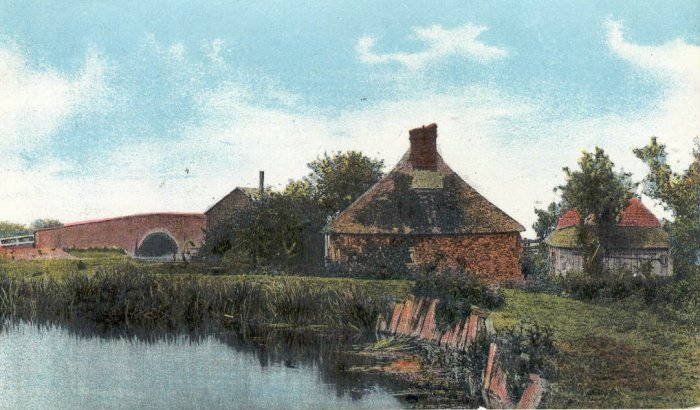
 |
Ludham
Bridge - a history
|
LUDHAM BRIDGES OVER
THE YEARS Notes by Mike Fuller

There have been 3 different bridges spanning the River Ant in the last 100 years. Here is a look back at them.
The first Ludham Bridge was built of brick and timber and had a single semi circular arch. It was in place up to 1912 and is thought to have lasted for 325 years. The bridge stood on 6 feet by 6 feet elm piles about 9 feet long. Some of these shoes and beetles (which they are called) are still in use as fencing in the village and are as hard as rock. The arch of the first bridge was slightly smaller than Potter Heigham Bridge. Wherries of 25 tons or under were the largest vessels to get through and most had to take their drop keels off.
This bridge was known as the Bung Hole and it seriously restricted the size of boats passing up the Ant to Barton Broad and on to the North Walsham and Dilham Canal. The bridge also had the effect of restricting the flow of water down the Ant and in the Great Flood of 1912 this made the flooding worse above the bridge.

Boats and a wherry downstream of the old bridge
The County Council took over the
structure from the Eccles Commission, and when in 1912
the great flood pulled the wall from the arch on the How
Hill side, work was put in hand to completely rebuild
it.
Mr. T.H.Blyth of Foulsham was entrusted with the task with the help of Hobrough's who drove in the piling from a wherry. This bridge, which stood until 1959, was built with 20ft pitch pine piles standing in a concrete foundation, 6 feet wide by 4 feet deep. It was completed in 1915. It had a straight span of 23 feet 10 inches made of steel with wood block flooring and with brick parapets and an 18 ft carriage-way.
Mr. T.H.Blyth of Foulsham was entrusted with the task with the help of Hobrough's who drove in the piling from a wherry. This bridge, which stood until 1959, was built with 20ft pitch pine piles standing in a concrete foundation, 6 feet wide by 4 feet deep. It was completed in 1915. It had a straight span of 23 feet 10 inches made of steel with wood block flooring and with brick parapets and an 18 ft carriage-way.
The new bridge occupied the same place
as the old one and had a larger and much more functional
square design.

The new bridge with brick piers and steel frame.
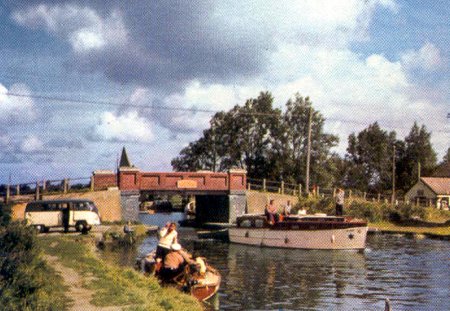
Ludham Bridge in the 1950s

The second bridge not long after it was built
In 1959 it was decided to straighten up the bridge and roadway. Another bridge was built and the road was widened. The new bridge was built of concrete and the piles already in place were re-used with the addition of some more concrete. The brick sides were taken down and replaced by concrete sides to complete the bridge as it is today.
This latest bridge was built a little further downstream from the old bridge and the approach roads were realigned. The old public staithe had always been downstream of the bridge and some of this was lost as a result. To compensate for this, a new staithe was constructed upstream of the bridge. Part of the old staithe still remains and is now part of Ludham Bridge Boatyard.

The current Ludham Bridge soon after it was built.
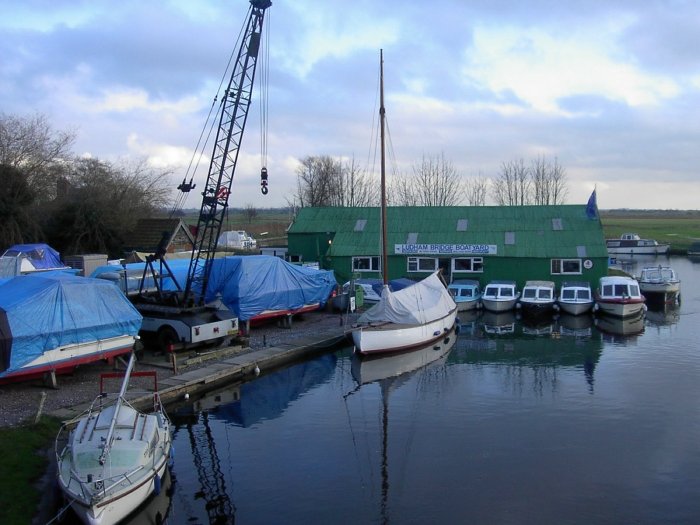
Looking downstream from the bridge.
In earlier days, the youngsters of
the village had a good swimming pool by the bridge
as there was always clean and deep water, They could
also dive or jump from the bridge on the downstream
side.
That same side was also used for loading and unloading of goods by wherry. Horning also used the opposite bank for the same purpose. The goods were reed, sedge, corn, sugar beet, bricks, stone etc.
That same side was also used for loading and unloading of goods by wherry. Horning also used the opposite bank for the same purpose. The goods were reed, sedge, corn, sugar beet, bricks, stone etc.
PARKINSON'S SHOP

In the 1930s, the area immediately
upstream of the bridge was occupied by A.L.
Parkinson's shop. This shop operated up until the
Second World War. It was closed on government orders
and the bridge was fortified. The photograph shows
the area occupied by the current staithe.
FLOODS
Flooding caused the loss of the old bridge and they still happen on a regular basis. The following picture shows a flood near the bridge. The line of the river bank is just visible to the left of the wherry.
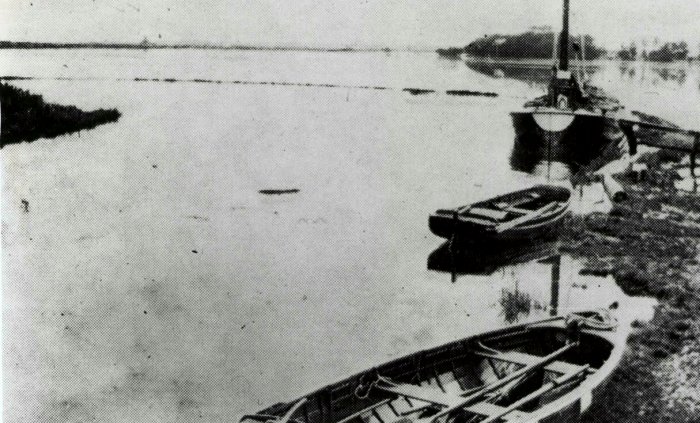
The following 3 pictures show the 1992 flood
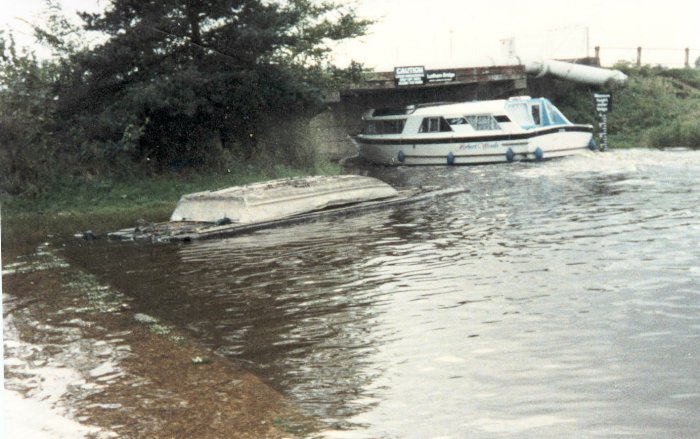
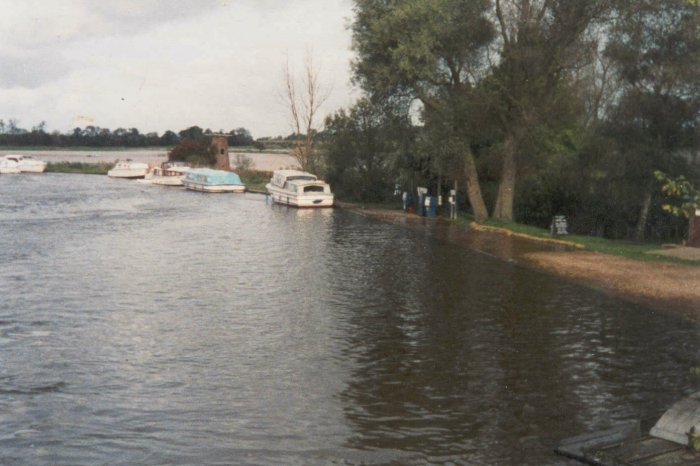
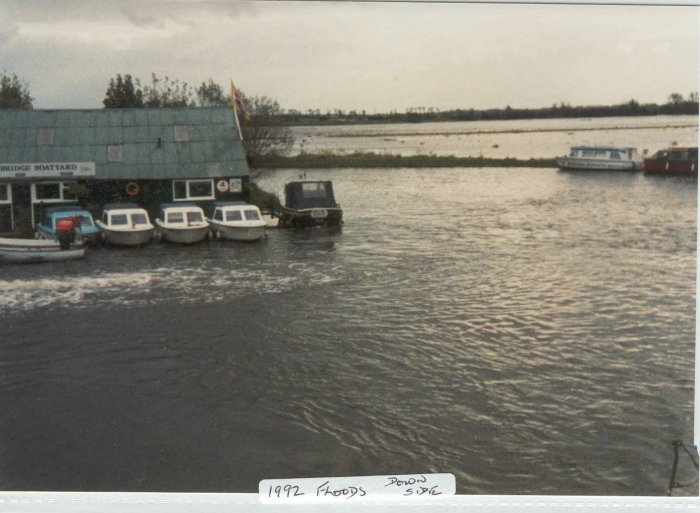
COTTAGE
This cottage was located on the riverbank just downstream of the bridge in the place now occupied by the boatyard. No trace remains of the building.
